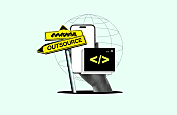
Have you ever wondered about the real price tag of innovation in construction? Building a skyscraper is a complex dance of physical labor and cutting-edge technology, much like developing software for construction itself. It's a field where every decimal point shaved off the project's budget or timeline can mean significant savings, but what's the actual construction software development cost that makes these efficiencies possible?
Join me as we lay the foundation (quite literally) for understanding the investments behind construction software development. From the initial blueprints to the final user interface, every step involves choices that impact the bottom line. Let’s drill down into the costs that make up this technological cornerstone of modern construction.
How Much Does It Cost to Build Construction Software?
While there is no construction software development cost calculator that can give you an accurate price for your solution, we have compiled a table that gives a close estimate of the cost you can expect.
Construction Software Development Cost Breakdown by Complexity
| Aspect | Low Complexity | Medium Complexity | High Complexity |
|---|---|---|---|
| Initial Planning & Design | $5,000 - $10,000 | $10,000 - $25,000 | $25,000 - $50,000 |
| Software Development | $20,000 - $40,000 | $40,000 - $80,000 | $80,000 - $150,000 |
| Testing & Deployment | $5,000 - $10,000 | $10,000 - $20,000 | $20,000 - $40,000 |
| Maintenance & Updates | $1,000 - $5,000 per year | $5,000 - $10,000 per year | $10,000 - $20,000 per year |
| Training & Support | $2,000 - $5,000 | $5,000 - $10,000 | $10,000 - $20,000 |
Construction Software Development Cost Breakdown by Region
| Region | Initial Planning & Design | Software Development | Testing & Deployment | Maintenance & Updates | Training & Support |
|---|---|---|---|---|---|
| North America | $25,000 - $50,000 | $80,000 - $150,000 | $20,000 - $40,000 | $10,000 - $20,000 per year | $10,000 - $20,000 |
| Europe | $10,000 - $25,000 | $40,000 - $80,000 | $10,000 - $20,000 | $5,000 - $10,000 per year | $5,000 - $10,000 |
| Asia | $5,000 - $10,000 | $20,000 - $40,000 | $5,000 - $10,000 | $1,000 - $5,000 per year | $2,000 - $5,000 |
Factors Affecting the Cost of Construction Software Development
There are a lot of elements that come into play when you develop construction software. And different elements mean different costs associated with them. Here is a detailed explanation of some of these factors and how they influence development costs:
1. Scope of the Project
To estimate the construction software development cost, one must first define the scope of the project. This includes having answers to questions like:
- Features and Functionality: What specific features does the software need? For instance, project management tools, budgeting and financial tracking, scheduling, or resource allocation functionalities. Many opt for an ERP for construction company that integrates various functions (procurement, project management, finance, etc.) into one platform. This can influence development costs.
- Target Users: Is the software intended for internal use by project managers and staff, or is it aimed at clients and subcontractors? Different user groups may require different functionalities and interfaces.
- Integration Requirements: Will the software need to integrate with existing systems (like ERP or CRM software)? Integration can significantly affect development time and costs.
2. Development Approach
The development approach you choose can greatly influence costs. There are several options to consider:
- Custom Development: Developing customized software to suit particular requirements is highly recommended. However, it is the most costly choice.
- Off-the-Shelf Solutions: These are pre-built software packages. You can purchase and implement these solutions quickly. They are usually cheaper but may not meet all your specific requirements.
- Hybrid Approach: To balance construction software development cost and functionality, one may opt for a compromise of integrating some unique aspects to the off-the-shelf solutions.
3. Technology Stack
The choice of technology stack (the combination of programming languages, frameworks, and tools used in development) can impact the cost significantly. Hence, there are certain factors to consider:
- Programming Languages: There are differences in complexity, developer availability, and support among programming languages. For instance, Java and Python are popular choices for backend development.
- Frameworks and Libraries: Development can be hastened by using proven frameworks. However, this may attract licensing fees or require long-term support. Thus, increasing the overall cost of developing construction software.
- Platform: To figure out cost, one must also ask questions like is the software going to be designed for the web, mobile, or desktop? There are nuances in developing for each of these platforms, and they also have different costs.
4. Development Team
The composition of the development team is another cost factor that we think holds precedence. The construction software development cost can vary depending on details like:
- In-House vs. Outsourcing: Going with an in-house team can certainly provide better control over the project. However, it will cost more in terms of salaries and overhead to hire an exclusive internal team. Whereas outsourcing software development companies can lead to slight communication challenges. Nevertheless, you can get a solution at very low costs.
- Expertise and Experience: Experienced developers typically command higher rates. However, their expertise can lead to a more efficient development process and a higher-quality product.
5. Project Timeline
Time is a crucial component of construction software development costs. A longer timeline often means higher costs due to:
- Extended Labor Costs: Prolonged development requires more hours of work, translating into higher expenses.
- Market Changes: The construction industry is dynamic; delays can result in changes in requirements or increased competition, necessitating adjustments that can inflate costs.
6. Maintenance and Updates
After the software is developed, ongoing maintenance and updates are essential for ensuring performance and security. We have seen that budgeting for these costs involves considering the following:
- Regular Updates: Software must be updated to remain compatible with new technologies and regulations.
- Bug Fixes: Assigning resources for ongoing support to deal with emerging issues.
- Scaling Costs: With expansion of the business, the software might require scaling up which would mean more investments.
7. User Training and Support
Implementing new software often necessitates training for users, which can add to costs. Considerations include:
- Training Programs: Comprehensive training sessions may be necessary for staff due to the complexity of the software.
- Documentation and Support: Providing user manuals, FAQs, and ongoing support can incur additional costs.
In Conclusion
We've taken you through the layers of expenses and innovation, showing how each contributes to the final price of the software. As we wrap up this analysis of the costs of construction software development, it's clear that the stakes are as high as the buildings we hope to construct. Just like any other physical building, the development of robust construction software starts with a substantial investment in technology, talent, and time. However, construction software development companies are regularly keeping an eye on the latest trends and technologies that can improve your solutions and reduce costs simultaneously.
Frequently Asked Questions
-
How do you estimate a construction software development budget?
-
What is the typical construction software development cost model?
-
How long does it take to develop a construction software?
-
What are the hidden costs in construction software development?
-
What type of team is needed for construction software development?
-
How do custom features impact construction software development pricing?
-
Can a construction software project stay within budget?

Sr. Content Strategist
Meet Manish Chandra Srivastava, the Strategic Content Architect & Marketing Guru who turns brands into legends. Armed with a Masters in Mass Communication (2015-17), Manish has dazzled giants like Collegedunia, Embibe, and Archies. His work is spotlighted on Hackernoon, Gamasutra, and Elearning Industry.
Beyond the writer’s block, Manish is often found distracted by movies, video games, AI, and other such nerdy stuff. But the point remains, If you need your brand to shine, Manish is who you need.













